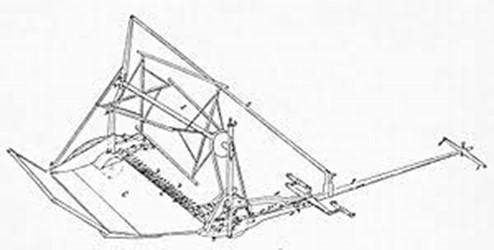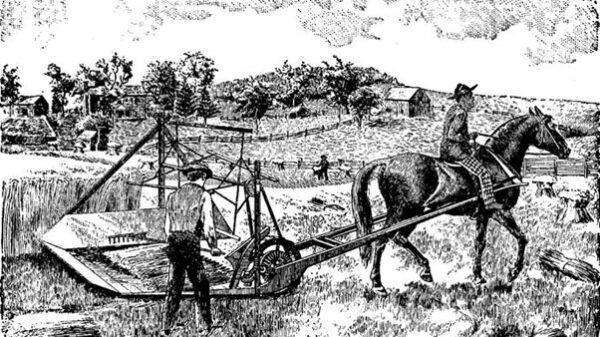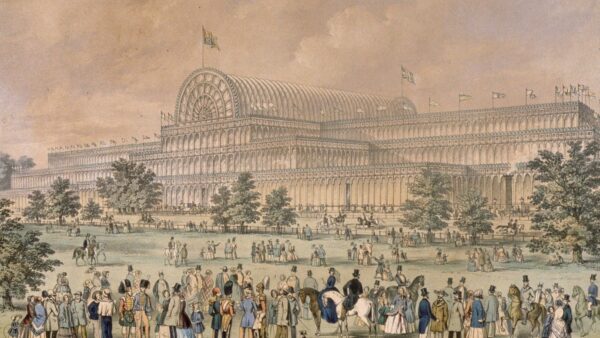John Common 1778 – 1868 – Inventor
The reaping machine transformed agriculture and life worldwide. Ever since man had begun raising grain for food the crop had been cut down laboriously by hand. Suddenly one machine could do in an hour what took many people all day to achieve. The effects of this were profound, raising the efficiency and yields of farms worldwide, but also rendering millions of farm labourers redundant. This in turn generated a workforce for the booming, overcrowded factory towns of the 1800s.
John Common was one of the first – even possibly the first- to create a practical mechanical reaper. Unfortunately he never patented his model, and hence gained none of the huge rewards the device created. As the Durham Chronicle said:
DEATH OF THE INVENTOR OF THE REAPING MACHINE.–
Mr John Common of Denwick, near Alnwick, died on Sunday evening week, in the 91st year of his age. He is justly entitled to renown for his many useful inventions and improvements in agricultural implements; especially for that admirable machine known as the American Reaper, of which it is well known to all who have made themselves acquainted with the facts of the case that he was the original inventor.
Durham Chronicle, 5th July 1868
Background
The Common family feature in local history for their longevity and physical strength.
Among the feats recorded are –
- One member of the family stood on his head on the steeple of Shilbottle church;
- Another stood on his head on highest tower of Warkworth Castle;
- One was able to leap through a hoop 2ft in diameter while a tall man held it above his head
- Another could leap forwards and backwards over a yoke of oxen.
- It is believed that John’s Great Grandfather Thomas, lived to over 110 years of age.
John Himself
John Common, son of Robert Common, a cartwright, was born in 1778. John lived at Denwick and was an inventor and maker of machines and agricultural implements. To supplement his income he worked at Park Farm in Hulne Park a certain number of days each week where he repaired implements, carts etc., for the estate of The Duke of Northumberland.
John invented a reaping machine but did not receive the acclaim, or the financial reward, he deserved for what was a ground-breaking invention.
The origins of John’s reaper
In about 1803, John met Henry Ogle, a local schoolmaster, who had considered building a reaping machine. He asked John for help and, following the latter’s advice, constructed a model, which was never developed.
John went on to make three different reapers.
-The first was a small one where the “shears were driven by a crank but it had no apparatus to deliver the corn”. John, in the company of a Mr Thomas Appleby, tried this one out in secret at night on his own corn at Denwick, where it performed well. By chance, Henry Ogle visited John and when he saw the reaper suggested that the Duke of Northumberland be told about it. His Grace was duly told about the reaper.
– The second machine, built on the same model as the first, was sent to the Society of Arts by Earl Percy in 1812 but the Society replied saying that it needed further trials. This model, drawn by horses, had been made to “clip the corn and to deliver it with rollers into a swathe”.
-The third machine was “made in full size in 1812 and, at the request of the Duke, to be drawn or pushed by men. The shears were driven by a sparrel instead of a crank and the corn was delivered into a swathe by an endless sheet moving over two rollers. It also had a fan to bring the corn to the shears”. It was tried at Denwick and worked well until something happened with the shears, which stopped the machine. After correcting it, the reaper was tried again, this time at Broomhouse, but the same thing happened. At this point, John Common stopped working on it, saying that it had cost him a great deal of trouble and money.
The patterns for the machine were kept by Mr Thomas Brown who had been given them to manufacture parts of the reaper at his foundry in Canongate, Alnwick. In 1822 a model by Henry Ogle, also made at Thomas Brown’s foundry, was displayed at Alnwick Market but the farmers showed no interest in investing in it and the workers expressed opposition, realising it would reduce employment opportunities.

An impression of the model reaper
How the plans left the country
In 1824 Mr Brown, the iron founder, left Alnwick, eventually emigrating to North America. He took with him the models of John Common’s reaping machine along with the patterns. Robert McCormick in America had for years attempted without success to make a reliable reaping machine. His son, Cyrus, took up the challenge and in 1851 he travelled to London to exhibit the American Reaping Machine in the Crystal Palace Exhibition, where it was awarded a gold medal. The reaper, which one observer likened to a “cross between a wheelbarrow, a chariot and a flying machine”, was said to be capable of cutting six acres of oats in one afternoon, the equivalent of 12 men working with scythes.

The McCormick Reaper

The Great Exhibition Building, 1851
A short while after the 1851 Exhibition, two of the reapers came through Denwick on the way to Howick. John Common went to see them at Howick and was surprised to find that they were exactly like the one he had made 40 years earlier! The machines were examined by two local farmers who had seen Common’s machine and confirmed they were identical.
A year or two after the Exhibition a Mr John Nichol, who was Mr Brown the iron founder’s son-in-law, met John Common at Alnwick Fair and told him “……. you are the very man I want to see”. He divulged to John that his wife had come from America and told him that McCormick had visited her father asking about the reaper and that her father, had handed over the patterns, knives etc., which had belonged to John Common and made a bargain with McCormick that if any money was made by it, that he (Brown) was to have a share. Brown died at the time of the Exhibition and McCormick refused to keep his part of the agreement.
Attempts to gain justice
In 1860 John contacted the Society of Arts in the hope of retrieving his model, which had been submitted to the Society in 1812 but was told that “it was not the custom to retain those for which no award was bestowed”. He was sent a copy of the society’s report on the 1812 examination of the model, with the comment by the secretary that “it is very remarkable to observe that the principle now used is distinctly that which you adopted in 1812”.
The publication of the Society of Arts reply seems to have prompted local farmers to raise subscriptions which provided a small pension for John Common. John died 28th June 1868 aged 90 and is buried in the churchyard at Shilbottle.
Among John Common’s other inventions was a double drill turnip sower for which, in 1818, he was awarded a silver medal and 10 guineas from the Society of Arts and 30 guineas from the Highland Society for the same invention.
We acknowledge the research of the late Vera Mallon in the creation of this article.

